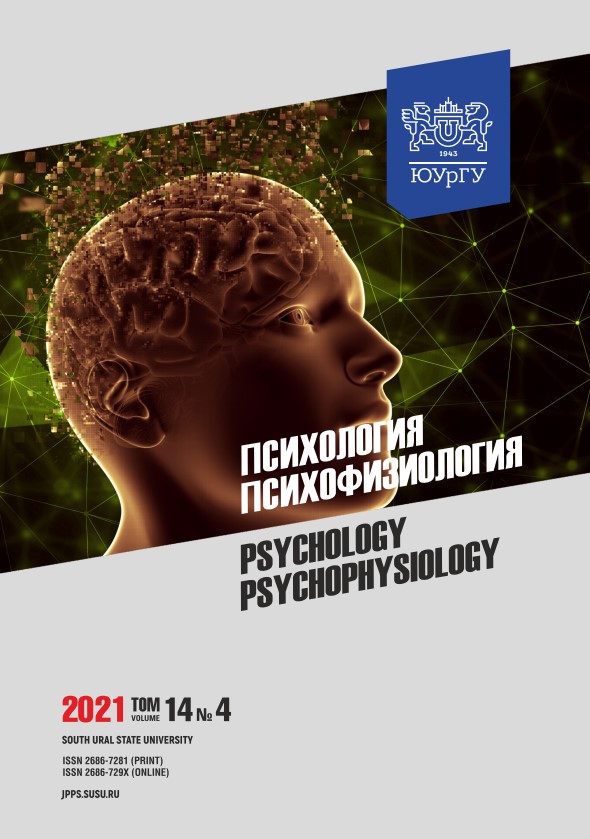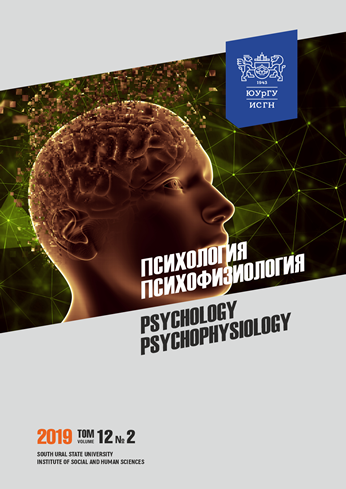ADAPTATION TO MENTAL ACTIVITY IN STUDENTS
Abstract
Abstract. Currently, considerable attention is paid to the adaptation of students, which is impossible without socio-psychological and psychophysiological factors. The mental activity of students is often accompanied by cognitive stress and stress reactions. Stressful situations are determined by many factors: disrupted daily activities due to time deficit, hypodynamia, bad habits, psychological overstress and fatigue. Any adaptation, especially in the first year at university, requires maximum efforts from all functional systems of the body. The aim of the review: analyze research materials on the mechanisms of adaptation of students to mental activity. Results. Psychophysiological features largely determine the effectiveness of mental activity and successful adaptation of students. Sustainable adaptation to learning environment mostly depends on the quantitative and qualitative characteristics of a person and has its own cost, which can later affect certain systems that experience the greatest load during adaptation. Discussion. The selection of markers to assess the effectiveness of adaptation to mental activity, especially in the academic environment, causes some difficulties. Many authors confuse the components of adaptation and do not describe the process itself. Therefore, new approaches to integral indicators are needed to determine the ability of a person to adapt to the academic environment. Such an approach was developed by V. Medvedev (2003), who proposed to assess personal and intellectual characteristics as adaptive resource and a complex of both general and specific indicators that characterized changes during mental activity. Conclusion. The article is based on works about the adaptation of students to mental activity and the role of individual psychophysiological indicators in the academic environment.
Downloads
References
2. Gevorkyan E.S., Minasyan S.M., Ksadzhikyan N.N., Dayan A.V. [The functional state of students under mental stress]. Gigiena i sanitariya = Hygiene and sanitation. 2005;5:55–57. (in Russ.).
3. Medvedev V.I. Adaptatsiya cheloveka [Human adaptation]. Saint-Petersburg: Institute of the Human Brain RAN Publ. 2003:270. (in Russ.).
4. Buduk-ool L.K. [Features of adaptation to training of students of the Republic of Tuva]. Ekologiya cheloveka = Human ecology. 2013;5:54–60. (in Russ.).
5. Leitin V.P., Nikolaeva E.I. Funktsionalnaya asimmetriya mozga. Mify i deistvitelnost [Functional asymmetry of the brain. Myths and effectiveness]. Saint-Petersburg: Slovo Publ. 2008:368. (in Russ.).
6. Fukui H., Toyoshima K. Influence of music on steroid hormones and the relationship between receptor polymorphisms and musical ability: a pilot study. Frontiers in Psychology. 2013;4:910. DOI: 10.3389/fpsyg.2013.00910
7. Litvinova N.A. Rol psikhofiziologicheskikh pokazatelei v mekhanizme adaptatsii k umstvennoi i fizicheskoi deyatelnosti [The role of psychophysiological indicators in the mechanism of adaptation to mental and physical activity]. Kemerovo: Kemerovo State University Publ. 2012:167. (in Russ.).
8. Shevchenko S.V. [Scientific positions in determining the criteria of mental work of first-year students]. Teoriya i praktika obshchestvennogo razvitiya = Theory and practice of general development. 2014;13:57–59. (in Russ.).
9. Wolfram M., Bellingrath S., Feuerhahn N., Kudielka B.M. Cortisol responses to naturalistic and laboratory stress in student teachers: comparison with a non-stress control day. Stress and Health. 2013;29(2):143–149. DOI: 10.1002/smi.2439
10. Konovalova G.M., Sevryukova G.A. [Adaptation of modern youth to the conditions of higher education: physiological aspect]. Vestnik Adygeiskogo gosudarstvennogo universiteta = Bulletin of the Adygea State University. 2011;3:81–92. (in Russ.).
11. Nikolaeva E.I., Kotova S.A. [Comparative psychophysiological analysis of the functional state of students of various forms of education at a pedagogical university]. Voprosy psikhologii = Questions of psychology. 2011;4:24–32. (in Russ.).
12. Nikolaev E.L., Komissarova N.I., Grigorieva N.N., Gerasimova M.N. [The potential of student youth health: personal and social risk factors]. Nauchno-meditsinskii vestnik Tsentralnogo Chernozemya = Scientific and medical Bulletin of the Central Chernozem region. 2010. No. 39-3. Sec. 16–21. (in Russ.).
13. Afinogenova O.I. [Features of adaptation of first-year students to the conditions of study at the university]. Novye issledovaniya = New research. 2011;1(26):55–59. (in Russ.).
14. Baiguzhin P.A. [Possibilities of optimizing the intensity of mental labor as factors of professional stress]. Vestnik Chelyabinskogo gosudarstvennogo universiteta = Bulletin of Chelyabinsk State University. 2012;3:378–396. (in Russ.).
15. Notova S. V., Davydova N. O., Cheremushnikova I. I. An integrated approach to determining the level of adaptation to university conditions among students of various social groups]. Vestnik Severnogo (Arkticheskogo) federalnogo universiteta. Seriya: Mediko-biologicheskie nauki = Bulletin of the Northern (Arctic) Federal University. Series: Medical and biological Sciences. 2014;2:56–62. (in Russ.).
16. Pavlova V.I., Kotova N.V., Kislyakova S.S., Saraykin D.A., Kamskova Yu.G. [Features of the functional state of the body of students in the process of studying at a medical university]. Sovremennye problemy nauki i obrazovaniya = Modern problems of science and education]. 2016;1:17. (in Russ.).
17. Akhtar M., Herwig B.K., Faize F.A. Depression and Anxiety among International Medical Students in Germany: The Predictive Role of Coping Styles. Journal of Pakistan Medical Association. 2019;69(2):230–234.
18. Schommer N.C., Hellhammer D.H., Kirchbaum C. Dissociation between reactivity of the hypothalamus-pituitary-adrenal axis and the sympathetic-adrenal-medullary system to repeated psychosocial stress. Psychosomatic Medicine. 2003;65(3):450–460. DOI: 10.1097/01. psy. 0000035721
19. Fink G. Stress consequences: mental, neuropsychological and socioeconomic. Academic Press, 2009:780.
20. Lung F.W., Lee F.Y., Shu D.C. The premorbid personality in military students with adjustment disorder. Military Psychology. 2006;18(1):77–88.
21. Garanyan N.G., Kholmogorova A.B., Evdokimova Ya.G., Moskova M.V., Wojciech V.F., Semikin G.I. [Pre-examination stress and emotional maladaptation in junior students]. Sotsialnaya i klinicheskaya psikhiatriya = Social and clinical psychiatry. 2007;2:38–42. (in Russ.).
22. Aizman R.I. Zdorove i bezopasnost uchastnikov obrazovatelnogo protsessa – klyuchevaya zadacha sovremennoi sistemy obrazovaniya [Health and safety of participants in the educational process – the key task of the modern education system]. Sbornik materialov mezhdunarodnoi nauchno-prakticheskoi konferentsii, posvyashchennoi 20-letnemu yubileyu Tuvinskogo gosudarstvennogo universiteta [Collection of materials of the international scientific and practical conference dedicated to the 20th anniversary of Tuva State University]. Kyzyl: RIO TuvGU Publ. 2015:132–134. (in Russ.).
23. Esaulenko I.E., Faustov A.S., Libina I.I., Gubina O.I. [The influence of learning conditions on the condition of students]. Vestnik Voronezhskogo gosudarstvennogo universiteta. Seriya: Problemy vysshego obrazovaniya = Bulletin of the Voronezh State University. Series: Problems of Higher Education. 2009;2:55–59. (in Russ.).
24. Anisimova T.G. [Peculiarities of adaptation of metropolitan and provincial students in the university environment]. Vlast = The Authority. 2013;1:95–98. (in Russ.).
25. Seliverstova G.P., Kunitskaya S.V. [Individual performance chronotypes and circadian rhythms of functional activity of blood circulatory system of students in gender aspect]. Uchenye zapiski universiteta im. P.F. Lesgafta = Scientific notes of the P.F. Lesgaft University. 2011;74(4):162–166.
(in Russ.).
26. Kuvshinov D.Y. [Periods of an individual year as a risk factor for changes in stress response, neurodynamics, blood pressure and NO metabolism in young men]. Perspektivy nauki = Prospects of science. 2010;4:11–14. (in Russ.).
27. Sidorova A.A. [Features of the adaptation process for psychology students in the first three years of study]. Vestnik Leningradskogo gosudarstvennogo universiteta im. A.S. Pushkina = Bulletin of the Leningrad State University named after A.S. Pushkin. 2011;5(1):36–48. (in Russ.).
28. Raghuram R. Theorising the Spaces of Student Migration. Population, Space and Place. 2013;19:138–154.
29. Aparin I.V. [Features of functional asymmetry of the brain in students with different chronotypes]. Studencheskii elektronnyi zhurnal StRIZh = Student electronic journal STRIZH. 2015;2(2):1–3. URL: www.strizh-vspu.ru (accessed: 14.01.2020). (in Russ.).
30. Barbarash N.A., Kuvshinov D.Yu., Kalentyeva S.V., Prokashko I.Yu., Tarasenko N.P., Chichilenko M.V., Shaposhnikova V.I. Individualnyi god cheloveka [The individual year of a person]. Kemerovo: INT Publ. 2011:220. (in Russ.).
31. Yaunakais N.A., Zolotukhina A.Yu. [Study of the dependence of the psychophysiological status on the chronotype of a person]. Vestnik Tomskogo gosudarstvennogo universiteta = Bulletin of Tomsk State University. 2010;15(1):100–104. (in Russ.).
32. Lane J.M., Vlasac I., Anderson S.G. Genome-wide association analysis identifies novel loci for chronotype in 100,420 individuals from the UK Biobank. Nature Communications. 2016;7:1–10. DOI: 10.1038/ncomms10889.
33. Levandovski R., Sasso E., Hidalgo M.P. Chronotype: a review of the advances, limits and applicability of the main instruments used in the literature to assess human phenotype. Trends in Psychiatry and Psychotherapy. 2013;35(1):3–11. DOI: 10.1590/s2237-60892013000100002
34. Zacharia T., James J., Prakash H., Mohan R.T., Rajashekhar B. The effect of circadian rhythm on the perceived tinnitus severity: A preliminary study. International Tinnitus Journal. 2014;19(1):41–45. DOI: 10.5935/0946-5448.20140006
35. Schlarb A.A., Sopp R., Ambiel D., Grünwald J. Chronotype-related differences in childhood and adolescent aggression and antisocial behavior – a review of the literature. Chronobiology International. 2014;31(1):1–16. DOI: 10.3109/07420528.2013.829846
36. Waterhouse J., Fukuda Y., Morita T. Daily rhythms of the sleep-wake cycle. Journal of Physiological Anthropology. 2012;31(1):5–19. DOI: 10.1186/1880-6805-31-5
37. Ogunsanya M.E., Bamgbade B.A., Thach A.V., Sudhapalli P., Rascati K.L. Determinants of health-related quality of life in international graduate students. Currents in Pharmacy Teaching and Learning. 2018;10(4):413–422. DOI: 10.1016/j. cptl. 2017. 12. 005
38. Dyson R., Renk K. Freshmen adaptation to university life: depressive symptoms, stress, and coping. Journal of Clinical Psychology. 2006;62(10):1231–1244.
39. Artemenkov A. A. [Change of vegetative functions in students during adaptation to artificial loads]. Gigiena i sanitariya = Hygiene and sanitation. 2007;1:62–63. (in Russ.).
40. Flegr J., Príplatová L. Testosterone and cortisol levels in university students reflect actual rather than estimated number of wrong answers on written exam. Neuro Endocrinology Letters. 2010;4(31):577–581.
41. Zhogoleva O.A., Dorokhov E.V., Karpova A.V. [The influence of anxiety and depression on the immune status of students in the presence of chronic information stress and the corrective role of speleoclimatotherapy]. Vestnik novykh meditsinskikh tekhnologii = Bulletin of New Medical Technologies. 2010;17(2):187–188. (in Russ.).
42. Grigorieva O.F., Kholueva K.A. [Features of the manifestation of anxiety in students]. Mezhdunarodnyi zhurnal eksperimentalnogo obrazovaniya = International Journal of Experimental Education. 2014;6-1:79. (in Russ.).
43. Panikhina A.V., Altynova N.V., Sirotkina L. A., Pavlov N. Yu. [Features of adaptation of junior students to the conditions of study at the university, depending on their state of health and modes of motor activity]. Vestnik Yuzhno-Uralskogo gosudarstvennogo universiteta. Seriya: Obrazovanie, zdravookhranenie, fizicheskaya kultura = Bulletin of the South Ural State University. Series: Education, healthy nutrition, physical education. 2009;39(172):31–36. (in Russ.).
44. Glebov V.V., Arakelov G.G. [Psychophysiological features and processes of adaptation of first-year students of different faculties of RUDN]. Vestnik RUDN. Seriya: Ekologiya i bezopasnost zhiznedeyatelnosti = Bulletin of the Peoples Friendship University of Russia. Series : Ecology and life safety. 2014;2:89–95. (in Russ.).
45. Sudakov K.V. Sistemnye mekhanizmy zdorovya [Systemic mechanisms of health]. Fiziologiya i zdorove cheloveka [Physiology and human health]. Moscow: Medicine-Health Publ. 2011:25. (in Russ.).
46. Engert V., Efanov S.I., Dushesne A., Vogel S., Corbo V., Pruessner J.C. Differentiating anticipatory from reactive cortisol responses to psychosocial stress. Psychoneuroendocrinology. 2013;38(8):1328–1337. DOI: 10.1016/j.psyneuen.2012.11.018
47. Molina P. Endocrine physiology. McGraw-Hill Medical, 2009:312.
48. Zarei M., Mohd N., Mohd T., Zarei F. Nutrition and Weight Management Knowledge, Dietary Intake and Body Weight Status in Iranian Postgraduate Students in Universiti Putra Malaysia. Pakistan Journal of Nutrition. 2014;13:351–358.
49. Yan Z., FitzPatric K. Acculturation and health behaviors among international students: A qualitative approach. Nursing and Health Sciences. 2016. Vol. 18. P. 58–63. DOI: 10.1111/nhs. 12232
50. Marcantonio T.L., Jozkowski K.N., Angelone D.J., Joppa M. Students alcohol use, sexual behaviors, and contraceptive use while studying abroad. Journal of Community Health. 2019. Vol. 44 (1). DOI: 10.1007/s10900-018-0554-5
References on translit
-Copyright (c) 2021 Psychology. Psychophysiology

This work is licensed under a Creative Commons Attribution-NonCommercial-NoDerivatives 4.0 International License.



